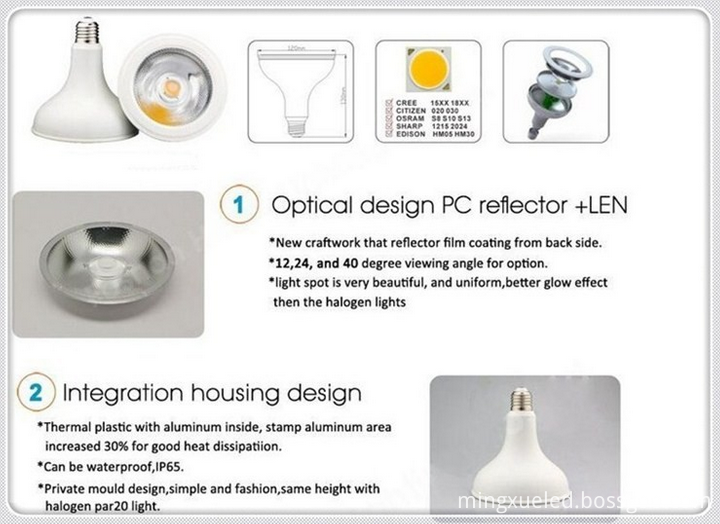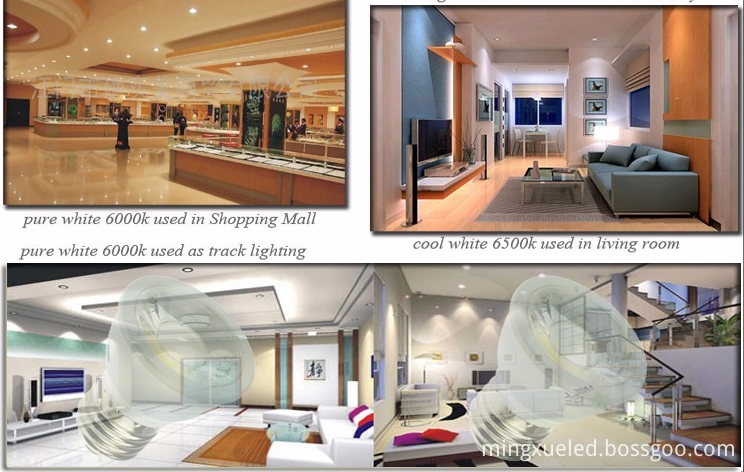According to tests conducted at the time, nearly ten different brands of energy-saving lamps used professional measuring instruments to generate alarm sounds. Electromagnetic radiation within 10 centimeters exceeded 200 volts/meter, and OSRAM energy-saving lamps radiated more than 1,600 volts. m; When the measuring instrument is 1.5 meters away from the energy-saving lamp, the value drops to a dozen volts/meter all at once, and the test is based on the current national “Electromagnetic Radiation Protection Regulationsâ€. The public safety lighting electromagnetic radiation value should be at 40V/m. Within. So, this kind of test science?
On March 26th, the reporter learned from the Shanghai Bureau of Quality Supervision that how harmful is the electromagnetic radiation to energy-saving lamps? On March 20th, Shanghai Bureau quickly conducted a special risk assessment and testing of “human body radiation safety†for various energy-saving lamp products sold in the city. The testing products were purchased from large-scale integrated supermarkets, large-scale professional lighting markets, and specialty stores in the city. All 87 samples basically covered domestic/international well-known brand products produced by enterprises in the city and by foreign companies, such as GE, PHILIPS, OSRAM, and Panasonic. , TESCO, "Asia", OPPLE, Sunshine, NVC Lighting, Snow Wright, FSL, etc.
After testing, the level of radiation emitted by 87 samples to the human body was within the standard F factor limit of 0.85, and no cases of excessive exposure were found.
The GB 8702-1988 “Electromagnetic Radiation Protection Regulations†adopted in media reports was organized by the Radio Environment Management Department of the then State Environmental Protection Agency in 1988. This standard proposes environmental protection including 40V/m. Electric field strength limit.
The risk assessment and testing indicated that the energy-saving lamp (specification name: self-ballasted fluorescent lamp) is a kind of lighting equipment. The Shanghai Bureau organizes the risk assessment and detection based on the current international scientific standard IEC62493 on the assessment of human radiation by energy-saving lamps: 2009 “Evaluation of Human Electromagnetic Emissions from Lighting Equipmentâ€, which is based on the biological impacts identified by the International Commission on Non-Ionizing Radiation Protection (ICNIRP) and the limits of human exposure to radiation fields, giving acceptable human radiation limits and Radiation limit test method.
The GB 8702-1988 standard does not apply to energy-saving lamp products. First of all, the applicable frequency range of the current specified by the GB 8702-1988 standard is 100 kHz-300 GHz, and the frequency range of the energy-saving lamp operating current is between 30 kHz and 50 kHz. This standard is not applicable.
Second, the test methods used do not meet the IEC standards and actual use. When measuring the electric field strength of 200V/m to 380V/m in the media report, the measuring probe is close to the energy-saving lamp, and the test distance is 0-10cm. This is inconsistent with the distance between the human body and the energy-saving lamp during actual use and does not meet the requirements. The international standard IEC 62493:2009 "Evaluation of electromagnetic radiation from lighting equipment for human body" specifies the measuring distance. GB 8702-1988 "Electromagnetic radiation protection regulations" does not specify the measurement method, and the international standard IEC 62493:2009 specifies specific test methods and test instruments for testing.
Energy-saving lamps have a lot of problems with electromagnetic radiation? It also attracted the attention of Yu Anqi, Chairman of the Shanghai Lighting Institute, and experts in the lighting industry. Experts believe that this situation has clearly deviated from the original features of energy-saving lamp radiation. According to Yu Anqi, the current standard for the protection of human body by electromagnetic radiation of lighting appliances is IEC 62493:2009, “Evaluation of Human Electromagnetic Emissions by Lighting Equipmentâ€. Previously there was a media report that used the criterion for the excessive emission of energy-saving lamps. GB 8702-1988 "Electromagnetic radiation protection regulations", now to see a lot of content with current technology standards to measure has become obsolete, there are many non-applicable energy-saving lamps radio radiation impact on human body judgments.
Yu Anqi believes that the harm of radio radiation to the human body is different from that of the human body because of the different frequencies. Therefore, there is a “weighted network†for each frequency segment, so that the final judgment result is in line with the actual situation. What we are now seeing is There is neither a qualified measurement environment nor a necessary spiking network. The standard applicability is wrong. It is simply not scientific.
Experts further explained that the working frequency of energy-saving lamps is generally in the range of 30 kHz to 50 kHz, and may reach 100 kHz when switched on, ie, 30,000 Hz to 50,000 Hz. At start-up, 10 megahertz, but the frequency and radio radiant intensity are two completely different quantities. The high frequency does not indicate a large radiant intensity. Our mobile phones all work at 900 MHz to 1800 MHz, several million hertz to several thousand hertz, and use high frequencies. Frequency (30kHz ~ 50kHz) to light fluorescent tubes, instead of 50Hz power frequency lighting, it is a great advantage. In addition, high-frequency lighting can increase the luminous efficiency by 8% to 10% at the same power. Therefore, most countries in the world currently accept high-frequency current-driven fluorescent lamps.
As for the comments made by relevant experts, Yu Anqi believes that none of the “inaccurate†words published in the “energy-saving lamp radiation†is a recognized expert in the field of lighting appliances.
Yu Anqi said that in terms of the amount of radiation in the wireless current segment, the radiation of the mobile phone is far greater than the radiation of the energy-saving lamp, and when the mobile phone is in use, it is closer to the human brain, so there is no need to worry about the radiation of energy-saving lamps.
In fact, since 2008, with regard to the quality of energy-saving lamp products, all levels of government (national and Shanghai) surveillance inspections have increased the detection and determination of the standard requirements of the “Restrictions and Measurement Methods for Radio Disturbance Characteristics of Electrical Lighting and Similar Equipmentâ€. As long as the product conforms to the standard CB 17743-2007 "Restrictions and Measurement Methods for Radio Disturbance Characteristics of Electrical Lighting and Similar Equipment," its product quality is in compliance with the requirements.
The Shanghai Bureau of Quality Supervision's risk detection also proves this point. From the results, the main energy-saving lamp products sold in Shanghai, energy-saving lamp power from 4W to 48W, basically covering the current household energy-saving lamp home energy range is in line with Radiation safety requirements for the human body.
led Spot Light is a typical no main light, no fixed size of a modern genres lighting, interior lighting can create the atmosphere, if a row of small Led Spot Light combine light energy changes fantastic patterns. Due to the small Spot Light can freely change the angle, the effect of a combination of lighting is also changing,like dim to warm par light. Spot light, soft, elegant, led Spot Light can also be local lighting, heighten the atmosphere.

Features:
Led Spot Light can be placed around the ceiling or the upper furniture, can also be placed in the wall, skirt or skirting. Light directly on the need to emphasize the objects on the home to highlight the subjective aesthetic effect, to highlight the unique environment, rich layers, the atmosphere rich, colorful artistic effect. led Spot Light soft, elegant, can play a leading role in the overall lighting, but also local lighting, contrast atmosphere.

Led Spot Light Function:
1) Save energy: The same power LED lamp power consumption is only 10% of incandescent, but also energy than fluorescent.
2) Long life span: LED lamp beads can work 50,000 hours, than fluorescent lamps and incandescent lamps are long.
3) Dimmable: Previous dimmers have been for incandescent, incandescent light dimming red; difficult to see fluorescent dimmers, which is dimming technology for many years did not develop the main reason; now the LED can dim , And whether it is light or dark light is the same color (color temperature basically unchanged), which is significantly better than incandescent dimming.
4) Low calorific value: Like led Spot Light, a lot of 220V spot with a few days is not broken because of fever. 12V halogen spotlights, although the heat is lower than the 220V spotlights, but there are due to lack of power and other reasons with the transformer, the brightness of less than the nominal value. With LED lighting, no transformer can work for a long time.
Mingxue Optoelectronics Co.,Ltd. has apply the I S O 9 0 0 1: 2 0 0 8 international quality management system certificate, we apply the CE, RoHS and SAA certificate for our led lighting product.


led Spot Light
Led Spot Light,Ar111 13W/10W Dim Spotlight,Ar70 7W Dim Spotlight,Ar70 6W Non-Dim Spot Light
Shenzhen Mingxue Optoelectronics CO.,Ltd , https://www.mingxueled.com